The 'Star Wars' Cantina Scene: The Out-of-This-World Story Behind the Galaxy's Favorite Dive Bar
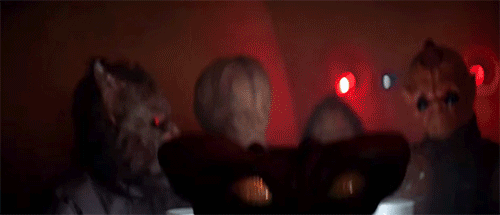
When Star Wars: A New Hope premiered in theaters in 1977, many a jaw dropped at the groundbreaking space adventure. The moment that really jolted audiences — the one that showed them they lived in creator George Lucas’s world now — was an early scene set in a drinking hole on the remote planet of Tatooine, populated by a wild assortment of aliens. The Mos Eisley Cantina, introduced by Jedi master Obi-Wan Kenobi as a “wretched hive of scum and villainy,” has been capturing the imaginations of fans for nearly 40 years — fans like director J.J. Abrams, who worked his own version of a cantina scene into the upcoming sequel Star Wars: The Force Awakens (and recruited a fellow cantina fan, Hamilton star Lin-Manuel Miranda, to compose the music).
Related: Rare Behind-the-Scenes Photographs of the ‘Star Wars’ Cantina
The scene is so much a part of our collective cinematic memory that its difficult journey to the big screen may come as a surprise. Lucas actually shot the scene twice, once in England and once in Los Angeles, using two entirely different teams of aliens and make-up artists. Many of those artists would go on to great fame in the film industry, including Thriller makeup-effects designer Rick Baker and Jurassic Park dinosaur supervisor Phil Tippett. For many Star Wars fans, in an era where every detail of the universe is documented online, the cantina scene remains a source of both fascination and mystery. Join Yahoo Movies as we delve into the complete history of the scene, featuring new interviews with effects artists and previously published recollections of George Lucas, John Williams, and other Star Wars collaborators lucky enough to have paid a visit to Mos Eisley.
Related: The Star Wars Trash Compactor: Dirty Secrets From The Franchise’s Smelliest Scene
Watch the cantina scene from ‘Star Wars,’ below.
PART I: LONDON
Though it occupies less than seven minutes of Star Wars, the cantina scene always loomed large in Lucas’s vision for the film. According to an interview printed in J.W. Rinzler’s The Making of Star Wars, before Lucas even had a plot for his epic space adventure, he “had some scenes — the cantina scene and the space battle scene.” In his original 14-page treatment for Star Wars, which he sent out to studio executives in spring 1973, Lucas described a “lazer sword” confrontation that occurred in “a shabby cantina,” a “murky little den… filled with a startling array of weird and exotic Aliens laughing and drinking at the bar.” Every subsequent draft of the script retained a scene in the alien bar, and an illustration of the cantina appears among the earliest Star Wars concept sketches by Ralph McQuarrie.
Less than a month after Star Wars began filming, Lucas saw his vision come to life on a soundstage at London’s Elstree Studios. To create the exotic alien clientele, he enlisted Stuart Freeborn, a special-effects-makeup artist best known at the time for his apes in 2001: A Space Odyssey. (In fact, Freeborn repurposed his leftover 2001 primate hands for several cantina creatures.) Helping Freeborn was a crew of six artists. One was Christopher Tucker, whose make-up for The Elephant Man would single-handedly inspire the creation of the Academy Award for Best Makeup a few years later. Another was a young assistant named Nick Maley, who aspired to do character makeup (and who would be promoted to a senior member of the creature workshop on The Empire Strikes Back). Maley, who now runs his own small Star Wars museum on the island of St Maarten, tells Yahoo Movies that Freeborn’s team had 10 weeks to assemble the dive where Luke Skywalker (Mark Hamill) and Obi-Wan (Alec Guinness) would first meet smuggler Han Solo (Harrison Ford) to arrange a ride on his ship, the Millennium Falcon.
Related: Rare Behind-the-Scenes Photographs of the 'Star Wars’ Cantina
Maley’s first assignment: making alien eyes, using a Freeborn-invented method of blowing compressed air through colored light gels. “It was really cold, and outside we had a vacuum machine that we used for making the eyeballs for all the characters,” Maley recalls. “So I was first relegated to that, I think, because nobody else wanted to go and do it.” From there, Maley was promoted to making prosthetic foam pieces. One of the many creatures Maley worked on was Greedo, the blue-green alien who has a fatal confrontation with Han. Nameless during production, the “Martian,” as the makeup team called him, was originally designed by Freeborn for a Bird’s Eye peas commercial. To distinguish the Star Wars alien from the extraterrestrial frozen-vegetable pitchman (named, appropriately, “Peabody”), the team added features to the mask, including ears, a snout, spiky hair, new eyes, the “foghorns” on his head, and hundreds of bumpy warts.
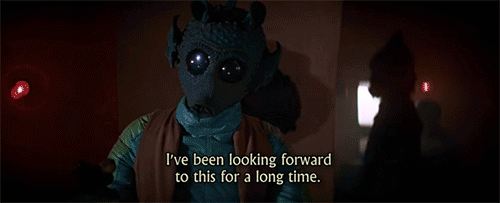
Greedo and Han Solo’s showdown. The scene was filmed in London, but the Greedo close-up would be re-shot in LA.
While Maley, Freeborn, and the crew were assembling creature makeup, costume designer John Mollo (Alien, Gandhi) was collaborating with Lucas to conceive of fashions for a motley assortment of peasants, pilots, and space pirates. Many of the aliens were cast via a London modeling agency called the Ugly Agency, which specialized (and still does, to this day) in “character models” with unique physical attributes.
All of these elements were designed to jolt audience members out of their familiar reality and fully into the world of Star Wars. “George didn’t really want to go way-out on the people, other than the creatures,” Freeborn, who died in 2013, said in The Making of Star Wars. “Because that was supposed to be a kind of ‘shock’ scene. Everything’s pretty normal up to that point in the film.“ Lucas was an active participant in the creature-making process at Elstree, stopping by once a week, occasionally bringing new ideas. Once, “he came in with a drawing of a multi-eyed blob that he’d done while sitting in the airport, and yeah, we built it, and we all hated it,” says Maley (who stands in front of that hooded creature in the center of the photo below).
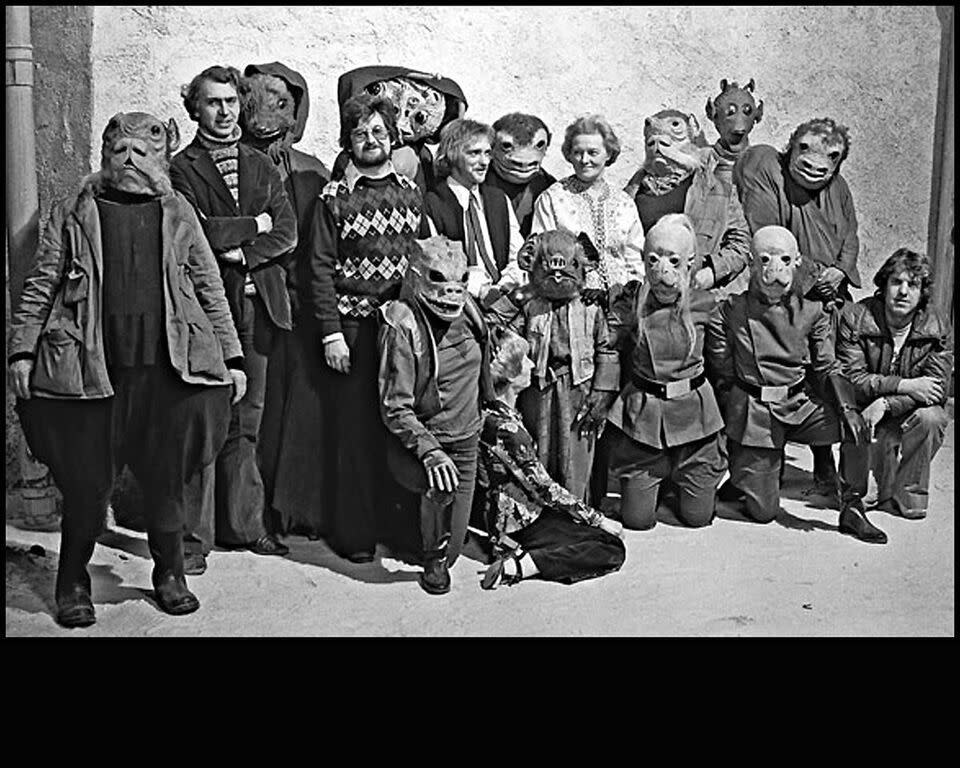
The London makeup team (minus Stuart Freeborn) with their cantina creatures. From left: Chris Tucker, Nick Maley (in argyle sweater), Graham Freeborn, Kay Freeborn and Sylvia Croft. Go here for more behind-the-scenes photos.
The London cantina scene was shot over several days in April 1976. (At one point, Carrie Fisher, who had not yet begun filming her scenes as Princess Leia, stopped by the set to get Lucas’s approval on her dual-bun hairdo.) The makeup crew kept busy working on the Cantina’s 42 extras, while Lucas shot the main cast’s scenes — including two altercations, one between Han and Greedo (played by Paul Blake, a friend of C-3PO actor Anthony Daniels), and one between Luke and Obi-Wan, and a pair of belligerent aliens at the bar. Maley worked on both of the aggressors in the latter scene, Ponda Baba (or “Walrus Man” to anyone who remembers his 1977 Kenner action figure) and Dr. Evazan (played by Ugly Agency recruit Alfie Curtis). To this day, the makeup artist remains displeased with Curtis’s distinctive facial prosthetic. “I always felt that the texture of the prosthetic didn’t really work terribly well with the texture of the actor’s face,” says Maley.
Related: How the Famous 'I Love You/I Know’ Scene From 'The Empire Strikes Back’ Really Came Together
As for the character of Ponda Baba, who loses an arm to Obi-Wan’s lightsaber, he underwent a crucial change during the Elstree shoot. Initially, Ponda was given flippers — what Maley called “sucker hands” — to match his aquatic appearance. When Lucas picked Ponda as the alien destined for behanding, Maley quickly crafted an arm with a flipper hand at the end, and Lucas shot the blood-covered arm lying on the floor. However — in an early foreshadowing of his later hand-wringing over Han shooting Greedo first — Lucas decided that he couldn’t have Obi-Wan maim an alien without justification. The Walrus Man, said Lucas, should be holding a pistol. Unfortunately, his flippers were ill-equipped to carry a weapon, so Ponda received new, furry hands. Eagle-eyed viewers will note, however, that when Ponda pushes Luke in the finished film, he’s still wearing his “sucker hands.”
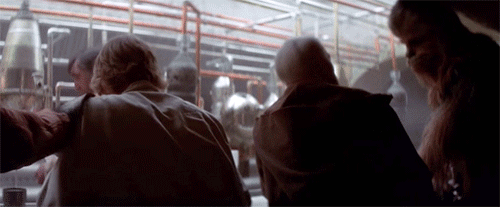
The walrus man, a.k.a. Ponda Baba, pushes Luke with his “sucker hands.” Go here for behind-the-scenes photos.
Those flippers are also clearly visible in a black-and-white rough cut of the cantina scene that has circulated among fans since being released on CD-ROM in 1998. Assembled entirely with footage from the London shoot, the scene is similar to the final cut, with a few additions (a mystery girl making out with Han Solo) and minor changes (Ponda’s sucker hands). But there are also glaring omissions, in the form of some of the Cantina’s most memorable creatures: the vaguely ET-looking alien who pops into the frame at the beginning of the scene, the hammer-headed creature nursing a drink, and of course, the band of identical alien musicians. These are missing from the rough cut because they were created by a different effects team and filmed separately, nine months later, during the second cantina shoot, in Los Angeles.
Why did Lucas film the cantina scene twice? Lucas’s most often-repeated story is that Freeborn fell ill during production, leaving some of his most striking creatures unfinished. Maley has no memory of Freeborn being hospitalized, but he does acknowledge that there was a rushed quality to the job, due to the skeleton crew, strict timeline, and cramped quarters (their “workshop” at the London studio was a tiny schoolroom set aside for child actors).
In retrospect, it seems clear that Freeborn’s conception of the creatures was not quite far-out enough for Lucas. Most of Freeborn’s creations were what Maley calls “very terrestrial,” grounded in human and animal forms. Yet Lucas consistently gravitated towards more unearthly, alien creatures like Greedo and Ponda, whose costumes fully concealed the actors inside. To put this conflict in perspective, Maley notes that no mainstream Hollywood movie had ever tried anything quite as ambitious as the cantina scene, in terms of introducing a slew of exotic creatures all at once. “Those things were so far outside the box that I think a lot of people felt that audiences in 1976 wouldn’t be able to handle something that extreme,” says Maley.
Related: The 10 Craziest, Most Blatant 'Star Wars’ Rip-Offs
PART II: LOS ANGELES
Nearly a year later, Lucas took a second stab at the cantina. Principal photography on Star Wars had wrapped in July 1976, and with the effects team at Industrial Light and Magic hard at work, the director scheduled pick-ups and reshoots for January and February 1977. This time around, Lucas made sure to get his concepts for the aliens on paper. The director worked with science-fiction illustrator Ron Cobb (a future conceptual artist on Raiders of the Lost Ark and Back to the Future) on a series of creature sketches. The crew of aliens in Cobb’s drawings is thoroughly otherworldly, with features like bulbous heads, tentacles, webbed toes, and gigantic eyes. None looks as human as the creatures Freeborn designed — indeed, in some cases, it’s impossible to tell from the drawing how a human would even occupy the costume.
To solve that problem, Lucas turned to an up-and-coming creature designer named Rick Baker. Thanks to his work on the title character of 1976’s King Kong, Baker was already building a reputation in Hollywood as a groundbreaking makeup and effects artist (and would go on to win 7 Oscars). “George showed me the cantina scene as it existed on a flatbed editor, and I just got so excited,” Baker tells Yahoo Movies. “I thought even as it was, the scene was great! And the fact that he wanted to add more, and he was giving me the opportunity to do this, I was really excited about it.”
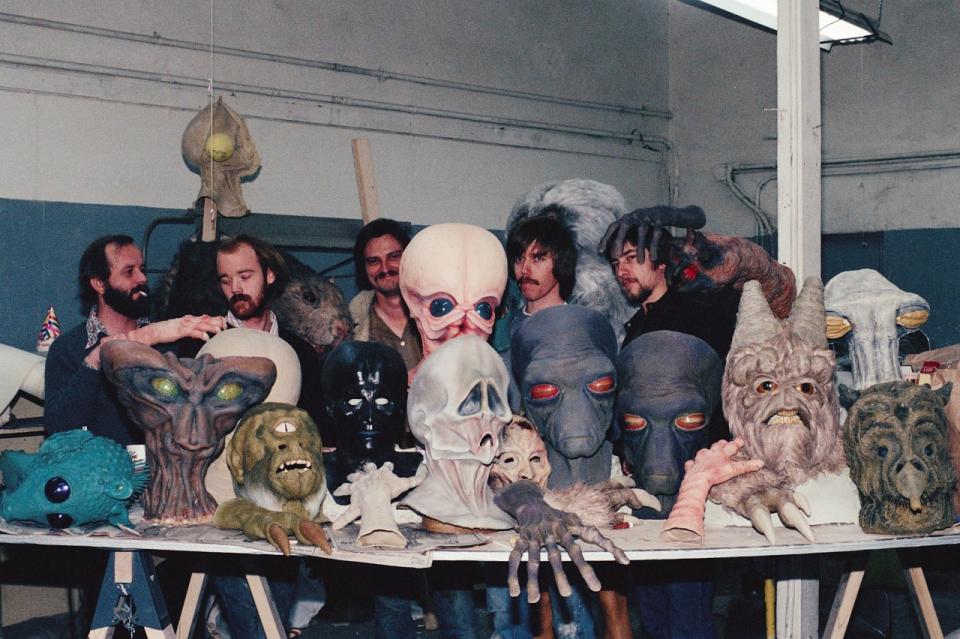
The Los Angeles makeup crew with their cantina creations. From left: Laine Liska, Phil Tippett, Jon Berg, Doug Beswick, and Rick Baker. (Image: Starwars.com via Facebook) Go here for more behind-the-scenes photos.
Baker loved the Cobb concept sketches, and had no shortage of his own ideas: He envisioned “makeups and animatronic things and puppets and all kinds of crazy stuff,” including “a space pirate who had, instead of a parrot on his shoulder, some little weird animatronic alien guy.” But time and money were in short supply; the special effects had pushed Star Wars over budget, and 20th Century Fox granted Lucas just $20,000 of his requested $100,000 for cantina reshoots. Lucas had to temper Baker’s expectations, telling him that most of the creatures would need to be accomplished with simple rubber masks.
With six weeks to make about 20 aliens, Baker assembled a crew of trusted friends from the stop-motion animation world. One of them was Phil Tippett, who would go on to design and/or animate such iconic Star Wars creations as Jabba the Hutt, the Rancor, and the AT-ATs. (He also returned to the Star Wars galaxy for The Force Awakens, reportedly to re-create the Millennium Falcon’s holographic chess board.)
“We were all fans of Lucas — we liked THX 1138 and American Graffiti, so we were all excited that a good filmmaker was making a sci-fi adventure thing, like we’d always wanted to work on as kids,” Tippett tells Yahoo Movies. Joining him in the creature shop were artists Jon Berg (who would work on Ghostbusters and Gremlins), Laine Liska (Alien 3, Flight of the Navigator), Doug Beswick (The Terminator, Aliens), and future The Howling and Fight Club makeup artist Rob Bottin. Baker, who had a prior commitment to a movie called The Incredible Melting Man, was in and out of the workshop. (“The Incredible Melting Man was paying me more [than Star Wars], which I think is pretty funny,” Baker recalls.) Using molds from some of Baker’s previous masks, Ron Cobb’s sketches, and their own ideas, the artists happily worked overtime to assemble the wackiest cantina creatures they could imagine.
The team’s creations included, among others, a four-eyed, furry creature that involved a full-body costume; a snake-like creature operated as a hand puppet, which was intended to ooze slime (an effect that didn’t make the final cut); the hammerhead alien, a puppet that consisted of a torso and two arms; and of course, the bulbous-headed band, later dubbed Figrin D'an and the Modal Nodes. To fill in the gaps, Baker offered Lucas some masks he had made “just for fun,” with the intention that they could be “stuck in the background.” Just one character was carried over from the London set: Greedo, whose close-ups Lucas wanted to re-shoot. Baker’s team took Freeborn’s mask and added mechanisms to move Greedo’s antennae and tiny mouth, which had been notably immobile in London.
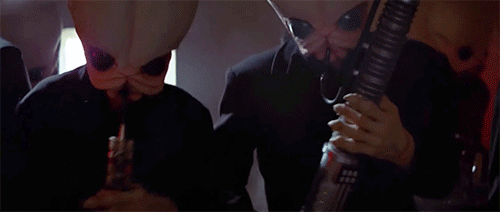
The cantina band, played mostly by members of the makeup crew – who were nearly suffocated by the large rubber masks. Go here for behind-the-scenes photos.
The Los Angeles cantina shoot took place over two days in January 1977. Because of the scene’s budget restrictions, the creature performers were members of the makeup crew and assorted Lucasfilm employees. “There was a cattle call; they had secretaries and people from accounting” says Tippett. “We [the makeup artists] had fashioned a number of the suits using ourselves as models, so we fit into them.” A minimalist version of the original set was created with four cantina locations, and Tippett remembers that “we just jumped around from set to set to set, putting on masks and costumes and taking them off and putting others on.”
Canadian actress Maria De Aragon was hired to play Greedo for the reshoots (hence that widely circulated behind-the-scenes photo of Greedo wearing pumps, below), but most of the performers were required to perform multiple aliens. At one point, the whole makeup crew bopped along to a jazz cassette while dressed as members of the cantina band. Tippett played the lead musician, “which was frustrating for everybody because I have absolutely no sense of rhythm,” he says. With second unit director Carroll Ballard working the camera, Lucas directed the performers in his trademark taciturn style. “‘Turn around slower.’ ‘Poke it harder.’ It was that kind of stuff,” recalls Tippett.
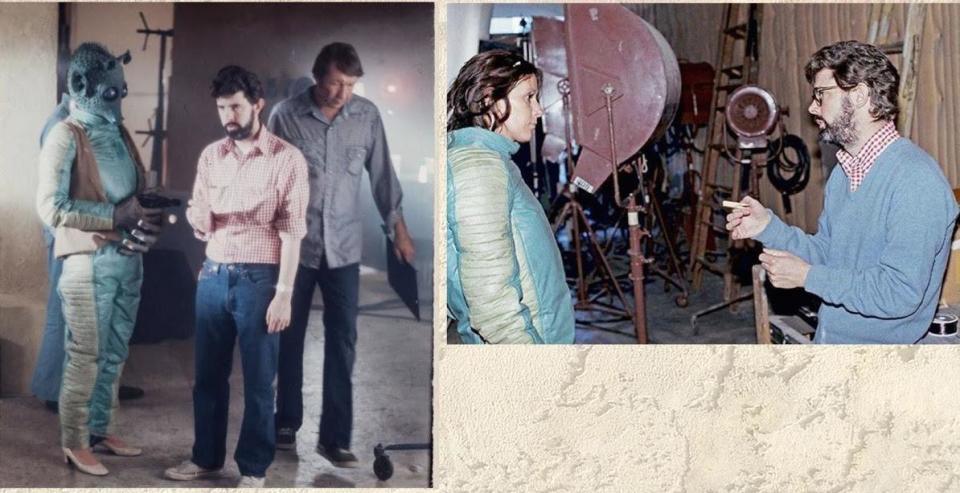
Actress Maria De Aragon as Greedo, with director George Lucas on the LA cantina set (Image: Lucasfilm/StarWars.com via Pablo Hidalgo and Tom Spina) Go here for more behind-the-scenes photos.
A few hiccups occurred over the two hurried days of filming. Greedo’s new mouth mechanism broke and had to be substituted with a clothespin, which De Aragon operated by holding it in between her teeth. And the heavy rubber masks worn by the cantina band nearly suffocated the makeup crew. “Once we put the masks on there was kind of like a gasket that went around our necks,” Tippett explains. “And the black eyes you could see through… fogged up really quickly. Our heads were sweating, and the masks started to fill up with sweat. So we were dying, and it was really hard to hear, you just couldn’t see.” Seeing the woozy performers, producer Gary Kurtz came to the rescue by getting out a Swiss Army knife and “poking the rubber right near our jugular veins to open everything up.” Baker, who had never before directed a crew of artists, says he neglected to mention that they should ventilate the slip-rubber masks. “They found out the hard way that you do need to see and breathe when you wear a mask,” he says with a chuckle.
Baker, who was not on set at the time, later learned that Lucas had selected some of his previously made masks for close-up shots — a decision that baffles him to this day. One was a devil head Baker had created for a film that he didn’t end up working on; another was a werewolf mask he had mass-produced and sold. “You know, I love Star Wars, and I was so excited to be involved with it… but I don’t really love George’s taste in aliens so much,” Baker admits. “I mean, we had some stuff that I thought was better, that never even ended up in the final film. And then he’s got a big close-up of this werewolf in the movie and I was going, ‘Oh my God! That should have never been there!’ It’s like, ‘Why didn’t you use that cool brain guy that we did?’”
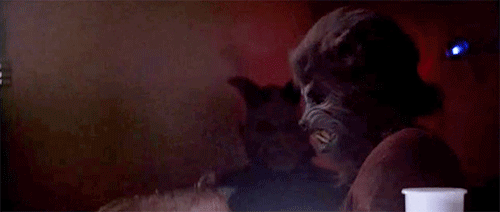
The snakehead puppet (later dubbed Dice Ibegon) and the werewolf alien (Lak Sivrak), with the devil creature in the background (later named Kardue'sai'Malloc, though his on-set nickname was “Louie”). Baker was surprised to see the werewolf and devil masks featured prominently in the scene.
In spite of the challenges, says Tippett, “everybody had a good time” shooting the L.A. cantina scene. No one was more enthusiastic than Lucas, who was finally creating the alien bar he’d envisioned for years. “George got really into it. He got a hot-glue gun and the characters that I had made from Ron Cobb’s designs, and he took the glue gun and wanted to put eye boogers on them,” says Tippett. “So he was doing that, and he said something like, ‘You know what? This is the most fun I’ve had on this whole movie. This is what I wanted to do.’”
Related: J.J. Abrams Confirms Name of New 'Star Wars’ Character Is Nod to Both Beastie Boys and 'Lost’
PART III: WELCOME TO THE CANTINA
The final cantina scene was seamlessly spliced together using footage from the two shoots. Greedo’s voice was added in post-production by sound designer Ben Burtt; according to The Making of Star Wars, Burtt hired a linguistics student to speak the ancestral Incan dialect of Quechua, which he then modulated electronically to produce Greedo’s alien language. The finishing touch was the band’s song, composed by composer John Williams, which plays beneath the entire sequence. Originally, Lucas told publicist Charles Lippincott (via The Making of Star Wars) that he envisioned the cantina band playing “a very bizarre, kind of primitive rock.” By the time the scene was shot, Lucas had changed his concept to a rusty, futuristic form of jazz. In an interview from this year’s Star Wars digital collection, Williams said, “What he said to me was, ‘Can you imagine these creatures in some future century having found in a time capsule or under a rock some place an old 1930s Benny Goodman swing band record? And can you imagine what their distorted idea of how to play it would be?’ So that’s more or less what I tried to do.”
When Star Wars premiered theatrically in May 1977, the Mos Eisley Cantina had exactly the effect Lucas had hoped for. Many critics singled it out for praise: Roger Ebert wrote in the Chicago Sun-Times that the cantina sequence was “the most fascinating single scene” in the film, saying, “As that incredible collection of extraterrestrial alcoholics and bug-eyed martini drinkers lined up at the bar, and as Lucas so slyly let them exhibit characteristics that were universally human, I found myself feeling a combination of admiration and delight.” The Washington Post’s Gary Arnold was similarly taken with Lucas’s “dive for monstrosities,” writing, “There’s a rapturous moment of whimsy during the cantina sequence in which we briefly glimpse one monster beginning to laugh heartily at another monster’s unheard joke… From that instant I felt complete confidence and pleasure in Lucas’ directions.”
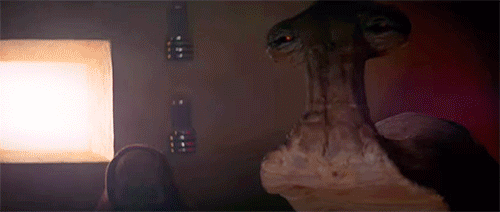
Cantina aliens react to Han shooting Greedo. These shots are a combination of footage from London and LA. Go here for behind-the-scenes photos.
Over the following three years, as Star Wars snowballed in popularity and shattered box office records, the cantina scene achieved the pre-Internet equivalent of going viral. The relentlessly catchy song reached the top spot on the Billboard Hot 100 in October 1977, thanks to a platinum-selling disco cover by musical artist Meco. (“It outsold the John Williams version,” Meco told Yahoo Movies. “I have the Guinness World Record for the best-selling instrumental single of all time.”) Greedo and three other cantina denizens — dubbed Hammerhead, Snaggletooth, and Walrus Man by Kenner — were among the first 20 Star Wars action figures to hit shelves and were sold together by Sears in an exclusive Cantina Adventure Set. The aliens were featured on Topps Star Wars trading cards in 1977 and starred alongside Bea Arthur in a lengthy segment of the infamous Star Wars Holiday Special in 1978. (Among its limited merits, the holiday special offers a better look at some of Baker’s designs, including the “brain guy” whose absence he lamented.) And in 1979, some of the more inebriated cantina aliens were even featured in a public service announcement about drunk driving (below).
A drunk driving PSA from 1979, set in the ‘Star Wars’ cantina.
PART IV: THE BAND PLAYS ON
Even after sequels The Empire Strikes Back (1980) and Return of the Jedi (1983), fascination with the cantina scene in A New Hope only grew. “The cantina draws a lot of interest from people with big imaginations, I think, because so much of it is in shadow,” says Pablo Hidalgo, creative executive of the Lucasfilm Story Group. “And it was shot in such a way that you’re only seeing snippets of what might be happening in the space.” Over the years, even the “background” creatures created by Baker and Freeborn have developed elaborate names and personal histories, thanks in large part to their inclusion in a New Hope role-playing game released in the late ’80s, a Star Wars customizable card game produced by Decipher from 1995 to 2001, and a 1995 short story anthology, Tales from the Mos Eisley Cantina. Characters and species inspired by cantina aliens (like the Ithorians, based on Phil Tippett and Jon Berg’s “Hammerhead” puppet) have since been featured in the prequel trilogy, the animated series The Clone Wars, and in all corners of the expanded universe.
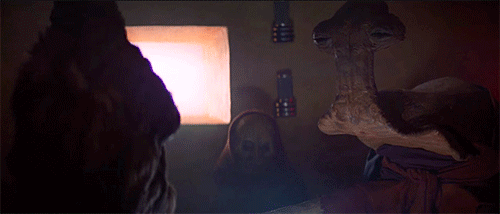
The “hammerhead” puppet at right was given the name Momaw Nadon and his own backstory (he’s a gardener living in exile on Tattooin) in the 1995 short story anthology ‘Tales from the Mos Eisley Cantina.’
Hidalgo has been personally obsessed with the Mos Eisley Cantina since childhood, when he would pause his VHS tape of Star Wars in order to sketch the creatures. In the ’90s, he built the website The Star Wars Index, one of the earliest fan attempts to catalog all the minutiae of the Lucas’s universe. The Index drew a community of similarly detail-oriented fans, including an effects artist named Tom Spina who shared Hidalgo’s lifelong fixation on the cantina aliens. He and Spina made it their mission to find out everything they could about the scene.
When Hidalgo was hired by Lucasfilm in 2000, it seemed like they would finally have all the answers. Not so. “People tend to assume that the Lucasfilm archive is incredibly complete, and it is in many places, but the cantina is one of those situations where there are still big holes in terms of the record,” Hidalgo explains. “We have a list of names, but connecting those names with the characters has always been problematic. And there are signature characters who have dominant screen time in that sequence” — for example, “Walrus Man” Ponda Baba — “that, to this day, we still don’t know who played them.”
The two super-fans have never stopped digging into the cantina’s mysteries, and they have presented their findings — including rare archival video, photographs, original masks, and the identification of previously unknown characters — to packed audiences at the Star Wars Celebration conventions in 2012 and 2015. Now, part of Hidalgo’s job for Lucasfilm is documenting the kinds of details absent from those cantina archives — character names, performers, the designers’ concepts — for new Star Wars films and projects. As for Spina, who runs the effects shop Tom Spina Designs, he has made a cottage industry of faithfully reproducing the cantina. In addition to restoring some of the original masks and costumes from Baker’s team, Spina’s crew has supplied cantina creatures for Volkswagen’s 2012 Super Bowl commercial, a Nerdist music video featuring Billy Dee Williams, a Lucasfilm/YouTube collaboration for May the 4th, an interactive Cantina set for Star Wars Celebration Anaheim, and a new Star Wars toy commercial. Outside of Spina’s work, the cantina has recently been re-created in Minecraft, spoofed in a trailer for Samantha Bee’s new late-night show, inspired a challenge on the Syfy makeup competition show Face/Off, and used to sell Subway sandwiches.
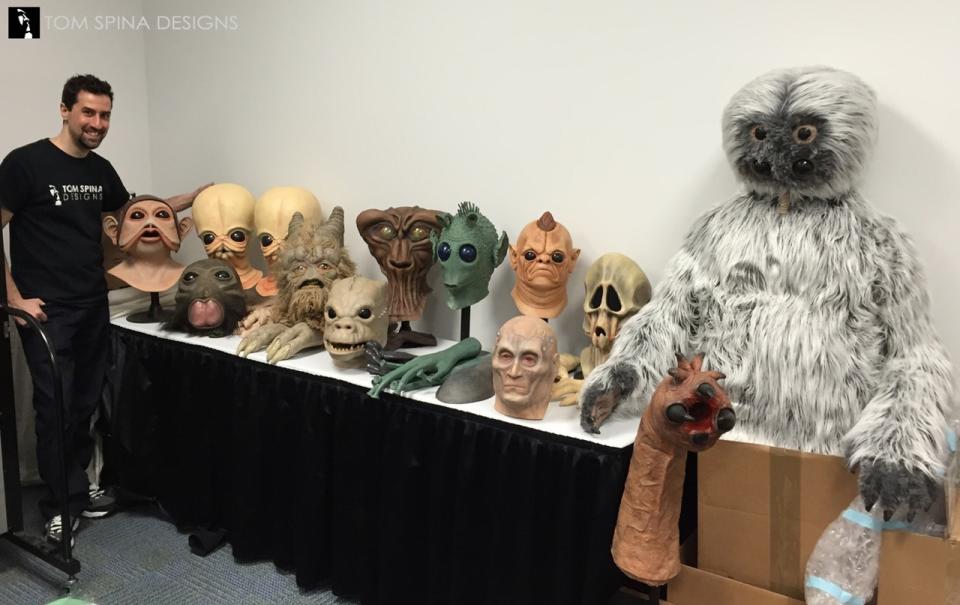
Tom Spina with cantina creatures replicated by his studio for Star Wars Celebration Anaheim (Image: Tom Spina Designs) Go here for more behind-the-scenes photos.
Nick Maley, who displays some of Spina’s Star Wars replicas in his museum, is still flabbergasted by the attention paid to his alien creations. “No one ever knew that someday people would be sitting on the Internet analyzing all these photographs of all the stuff we’d done!” he says.
But as Hidalgo points out, those six-plus minutes in the Mos Eisley Cantina, filmed in two countries over the course of a year, represent something essential about the Star Wars universe. “For people like me — we’re drawn to Star Wars as a destination,” he says. “And it’s a place that you can keep visiting because there’s always a sense of discovery, there’s always a corner to turn, a shadowy booth to shine a light on and all of a sudden you discover aliens you didn’t know existed. And so that sort of sense of discovery has always drawn to me to Star Wars, and what’s exciting to me personally now with all this new storytelling that’s emerging, that just means there are new places to visit and new corners to discover.”
That includes not just new films like The Force Awakens, but the Star Wars-themed lands being built at the Disney Parks. When Disney CEO Bob Iger presented the plans for Star Wars Land at this year’s D23 Expo, concept art of a cantina-like alien bar met with roars of approval from the crowd. Hildalgo can’t comment on whether the Disney attractions will include a real-life cantina, but he promises that the Star Wars Lands will honor the spirit of that scene, the sense of wonder and discovery that first took hold on the big screen in 1977. As the Star Wars universe continues to expand, there will always be a place for the “shabby cantina” Lucas envisioned a long time ago in a galaxy far, far away.
Read more: Our complete ‘Star Wars’ coverage
Watch J.J. Abrams talk about why Ava DuVernay should direct a ‘Star Wars’ movie:

